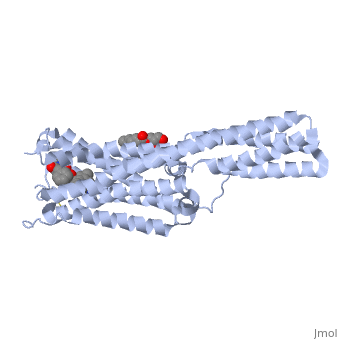5-hydroxytryptamine receptor
From Proteopedia
(Difference between revisions)
| Line 16: | Line 16: | ||
== 5HT-2B receptor agonists: Lysergic Acid Diethylamide (LSD)== | == 5HT-2B receptor agonists: Lysergic Acid Diethylamide (LSD)== | ||
| - | Lysergic Acid Diethylamide, more commonly known as LSD, is a potent hallucinogen and is derived from ergotamine, an ergopeptine whose structural skeleton is contained in a diverse range of alkaloids. LSD acts as a non-selective 5-HT receptor agonist, meaning it can bind with equal affinity to two or more sub-types of receptors. LSD actively binds in the <scene name='71/716548/5-ht2b/3'>orthosteric binding pocket</scene> to both the 5-HT1B and 5HT-2B receptors, suggesting a similar chemical structure and function between the two receptor families. The docking is stabilized by all the same residues involved in normal binding in the orthosteric pocket. Hydrogen bonding between the amino group of the 5-membered ring of LSD and the T140 residue of the 5-HT2B receptor, as well as hydrogen bonding between D135 and the other ergoline amino group stabilize the LSD in a similar fashion that 5-HT would bind to the receptor. <ref name = "one" /> | + | Lysergic Acid Diethylamide, more commonly known as LSD, is a highly potent hallucinogen and is derived from ergotamine, an ergopeptine whose structural skeleton is contained in a diverse range of alkaloids. LSD acts as a non-selective 5-HT receptor agonist, meaning it can bind with equal affinity to two or more sub-types of receptors. LSD actively binds in the <scene name='71/716548/5-ht2b/3'>orthosteric binding pocket</scene> to both the 5-HT1B and 5HT-2B receptors, suggesting a similar chemical structure and function between the two receptor families. The docking is stabilized by all the same residues involved in normal binding in the orthosteric pocket. Hydrogen bonding between the amino group of the 5-membered ring of LSD and the T140 residue of the 5-HT2B receptor, as well as hydrogen bonding between D135 and the other ergoline amino group stabilize the LSD in a similar fashion that 5-HT would bind to the receptor. <ref name = "one" /> |
==5-HT3 receptor antagonists== | ==5-HT3 receptor antagonists== | ||
Revision as of 22:24, 10 November 2016
| |||||||||||
3D structures of 5-hydroxytryptamine receptor
Updated on 10-November-2016
References
- ↑ Goodsell D. Serotonin Receptor. RCSB PDB-101 (2013) DOI: 10.2210/rcsb_pdb/mom_2013_8
- ↑ 2.0 2.1 2.2 2.3 Wang C, Jiang Y, Ma J, Wu H, Wacker D, Katritch V, Han GW, Liu W, Huang XP, Vardy E, McCorvy JD, Gao X, Zhou EZ, Melcher K, Zhang C, Bai F, Yang H, Yang L, Jiang H, Roth BL, Cherezov V, Stevens RC, Xu HE. Structural Basis for Molecular Recognition at Serotonin Receptors. Science. 2013 May 3; 340(6132): 610–614. PMID:3644373 [1]
- ↑ Wiebke J, Schymura Y, Novoyatleva T, Kojonazarov B, Boehm M, Wietelmann A, Luitel H, Murmann K, Krompiec DR, Tretyn A, Pullamsetti SS, Weissmann N, Seeger W, Ghofrani HA, Schermuly RT. 5-HT2B Receptor Antagonists Inhibit Fibrosis and Protect from RV Heart Failure. Biomed Res Int. 2015; 2015: 438403. PMID:4312574 [2]
- ↑ Nebigil, Etienne, Schaerlinger, Hickel, Launay, Maroteaux. Developmentally Regulated Serotonin 5-HT2B Receptors. DOI: 10.1016/S0736-5748(01)00022-3
- ↑ Berumen LC, Rodriguez A, Miledi R, Gracia-Alcocer G. Serotonin Receptors in Hippocampus. ScientificWorldJournal. 2012;2012:823493. Epub 2012 May 2. PMID:3353568 [3]
- ↑ Hassaine G,Cedric D, Luigino G, Romain W, Menno BT, Ruud H, Alexandra G, Henning S, Takashi T, Aline D, Christophe M, Xiao-Dan L, Frederic P, Horst V, Hugues N. X-ray Structure of the Mouse Serotonin 5-HT3 Receptor. Nature 512.7514 (2014): 276-81.DOI:10.1038/nature13552
- ↑ 7.0 7.1 7.2 Thompson AJ, Lummis SCR. 5-HT3 Receptors. Curr Pharm Des. 2006; 12(28): 3615–3630. PMID:2664614 [4]
- ↑ Maksay G, Zsolt B, Miklós S. Binding Interactions of Antagonists with 5‐Hydroxytryptamine 3A Receptor Models. Journal of Receptors and Signal Transduction 23.2-3 (2003): 255-70. DOI:10.1081/RRS-120025568
- ↑ Brunton LL, Lazo JS, Parker KL. (2006). Goddman & Gilman's The Pharmacological Basis of Therapeutics. New York: McGraw-Hill. pp. 1000–3. ISBN 978-0-07-142280-2.
Proteopedia Page Contributors and Editors (what is this?)
Michal Harel, Alexander Berchansky, Joel L. Sussman, Zachary Falk, Brittany Spence, Matthew P Cabrera, Jaime Prilusky

